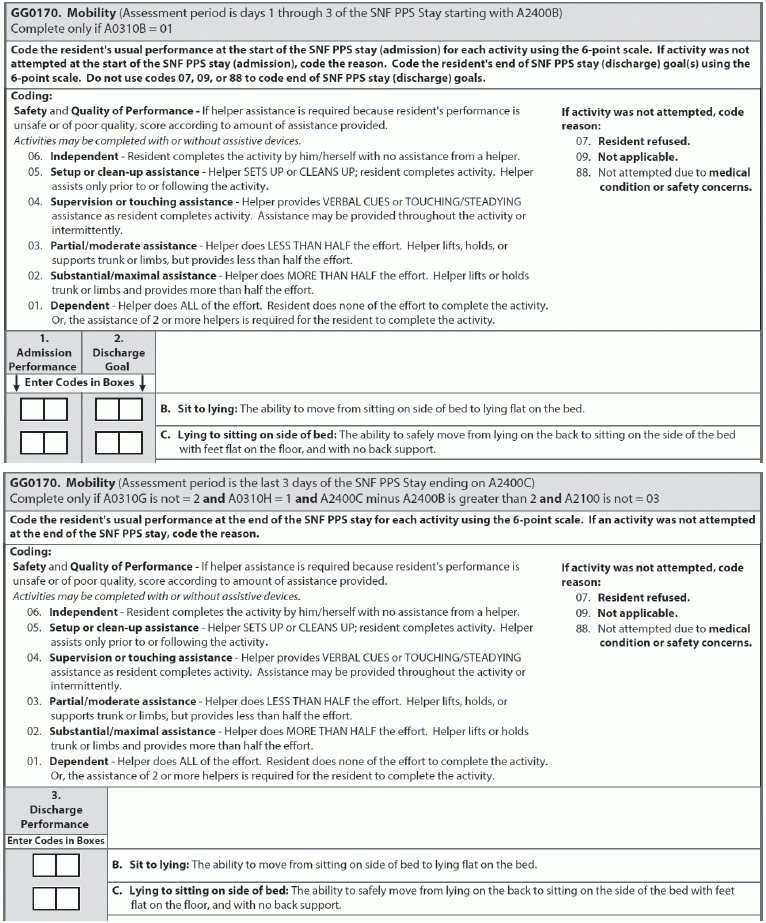Study 6 Item GG0170B/C Scenarios To Understand New Coding Conventions
Make sure you’re coding ‘Dependent’ when the helper does all the work.
When you’re coding a resident’s performance while transitioning from a sitting to lying position or vice-versa, you have a lot of movement to account for in the new Section GG — Functional Abilities and Goals items. Here are some scenarios from the latest RAI Manual that illustrate proper coding of items GG0170B — Sit to lying and GG0170C — Lying to sitting on side of bed:
Who Provided More Than Half the Effort?
Scenario #1: Mrs. Edwards suffered a pelvic fracture during a motor vehicle accident. She requires the CNA’s help to lift and position her left leg when she transfers from sitting at the edge of the bed to lying flat on the bed, due to severe pain in her left pelvic area.
Mrs. Edwards uses her arms to position and lower her upper body to lying flat on the bed. Overall, Mrs. Edwards performs more than half of the effort.
How to code: In this scenario, you would code item GG0170B — Sit to lying as 03 — Partial/moderate assistance, because Mrs. Edwards does more than half the effort. The CNA (the “helper”) lifts Mrs. Edward’s leg and helps her position it as the resident transitions from a seated to a lying position.
Scenario #2: Mr. Anderson suffered multiple vertebral fractures due to falling off a ladder. He requires a therapist’s assistance to get from a sitting position to lying flat on the bed due to significant pain in his lower back.
The therapist supports Mr. Anderson’s trunk and lifts both his legs to assist him from sitting at the side of the bed to lying flat on the bed. Mr. Anderson assists himself a small amount by raising one leg onto the bed and then bending both knees while transitioning into a lying position.
How to code: Here, you would code item GG0170B as 02 — Substantial/maximal assistance, because the therapist provided more than half the effort for the resident to complete the sit-to-lying activity.
Know When to Code ‘Touching Assistance’
Scenario #3: Mrs. Fletcher had a stroke about two weeks ago and is unable to sequence the necessary movements to complete an activity (apraxia). Mrs. Fletcher can maneuver herself when transitioning from sitting on the side of the bed to lying flat on the bed only if the CNA provides verbal instructions regarding the steps needed to complete this task.
How to code: In this case, you would code GG0170B as 04 — Supervision or touching assistance, because the CNA provides verbal cues only to help the resident complete the sit-to-lying activity.
Scenario #4: Mr. Gordon suffered a traumatic brain injury three months prior to admission. He requires the CNA to steady his movements from sitting on the side of the bed to lying flat on the bed. Mr. Gordon requires steadying (touching) assistance throughout the completion of this activity.
How to code: Again, code item GG0170B as 04, because here the helper provided steadying assistance so that the resident could complete the sit-to-lying activity.
Use the Same Conventions for Coding GG0170C
Scenario #5: Mr. Brown pushes up on the bed to attempt to get himself from a lying to a seated position as the occupational therapist provides much of the lifting assistance necessary for him to sit upright. The occupational therapist provides assistance as Mr. Brown scoots himself to the edge of the bed and lowers his feet to the floor. Overall, the occupational therapist performs more than half of the effort.
How to code: Code item GG0170C — Lying to sitting on side of bed as 02, because the occupational therapist provided lifting assistance that amounted to more than half the effort as the resident moved from a lying to sitting position.
Scenario #6: Mrs. Parker is being treated for sepsis and has multiple infected wounds on her legs. She needs full assistance from the CNA to move from a lying position to sitting on the side of her bed, because she usually has pain in her lower extremities when she moves.
How to code: In this case, you would code item GG0170C as 01 — Dependent, because the helper fully completed the lying-to-sitting activity for the resident.

